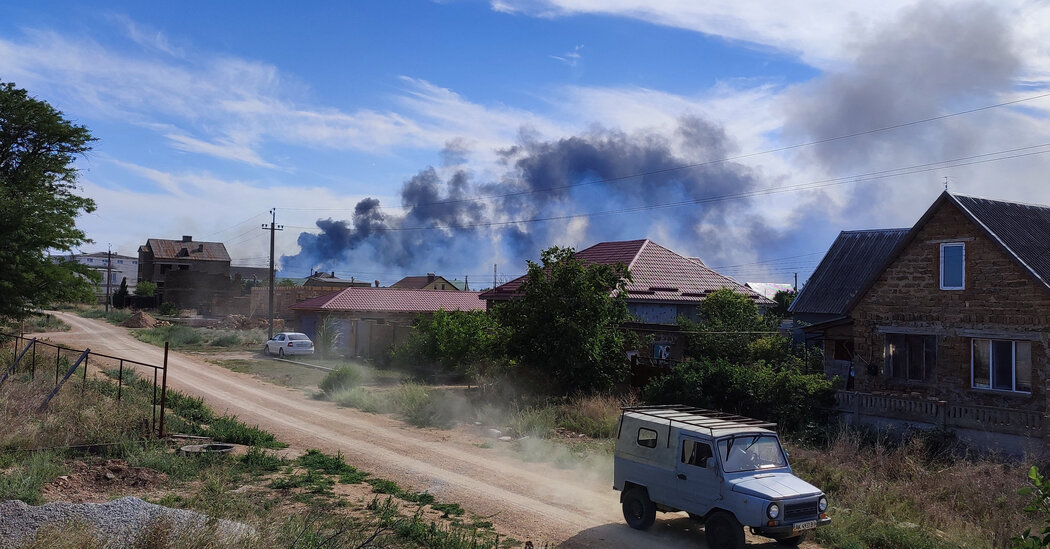A tally of damage near a Crimean air base contradicts the Kremlin’s assertions.

ODESA, Ukraine — Damage from a series of explosions at a Russian air base in Crimea appeared to be greater than the Kremlin has described, as officials on the Russia-occupied peninsula on Wednesday declared a state of emergency and said that dozens of nearby homes and commercial structures had been hit.
After the explosions on Tuesday, which a senior Ukrainian military official said were the work of Ukrainian forces, Russia’s Defense Ministry moved quickly to play down the extent of the damage, saying no equipment had been destroyed and no casualties reported.
The assertions were contradicted by a video from the scene and by a tally of the damage by officials in Crimea, a strategic peninsula in southern Ukraine that Russia illegally annexed in 2014.
The Kremlin-installed leader of Crimea, Sergei Aksyonov, said on Wednesday that 252 people had been relocated to shelters because of damage to their homes. At least 62 apartment buildings and 20 commercial structures had been damaged in the blast, a statement on Mr. Aksyonov’s Telegram page said, and officials were still cataloging damage to private homes.
Mr. Askyonov declared a state of emergency, apparently aimed at speeding up the rebuilding process. At least one person was killed and more than a dozen others wounded, officials said.
Damage to the base itself was harder to assess, but one video that emerged in the aftermath, and that was verified by The New York Times, showed the charred nose cone of a fighter jet, its fuselage a black, shapeless mass.
Although Ukraine has not officially taken responsibility for the explosions, a senior Ukrainian military official said on Wednesday that Ukraine’s special forces — along with local partisan resistance fighters loyal to the government in Kyiv — were behind the blasts. The explosions set off fireballs that startled beachgoers at a nearby Black Sea resort.
The official said the air base, Saki, on the western coast of Crimea, has been regularly used by Russian warplanes that have attacked Ukrainian forces in southern Ukraine. Speaking on the condition of anonymity to discuss delicate military matters, the official would not disclose the type of weapon used in the attack, saying only that “a device exclusively of Ukrainian manufacture was used.”

A satellite image of the Saki Air Base, in Crimea, taken on Tuesday, before an explosion was reported there.Credit…Planet Labs, via Associated Press
The blasts are potentially important because any Ukrainian attack on Russian forces in the Crimean Peninsula would be a significant expansion of Ukraine’s offensive efforts. Until now, Ukrainian forces have largely focused on pushing Russian troops back from territories occupied after Feb. 24, when their invasion began.
Ukraine possesses few weapons that can reach the peninsula, aside from aircraft that would risk being shot down immediately by Russia’s heavy air defenses in the region. The air base, which is near the city of Novofedorivka, is about 200 miles from the nearest Ukrainian military position.
Videos verified and reviewed by The New York Times showed that a plume of smoke was rising from the air base just before at least three explosions: two in quick succession and a third a few moments later. It is unclear from the videos what caused the blasts.
The senior Ukrainian official would not disclose whether the local resistance forces, known as partisans, carried out the attack or assisted Ukrainian military units in targeting the base, as has sometimes occurred in other Russia-occupied territories.
To reach targets deep behind enemy lines, Ukraine has increasingly turned to guerrillas in those territories, officials said. Partisans have, for instance, helped Ukrainian forces target Russian bases and ammunition depots in the Kherson region, Ukrainian officials say.
Russia’s Defense Ministry said in a statement that the explosion was caused by the detonation of stockpiled ordnance for warplanes at the base. While the ministry offered no speculation about whether Ukrainian forces might have been involved, a decision by Mr. Aksyonov to raise the terrorist threat level to yellow suggested that officials were concerned about security on the peninsula.
“This measure is exclusively prophylactic because the situation in the region is under full control,” Mr. Aksyonov said on Tuesday.
Christiaan Triebert contributed reporting.
